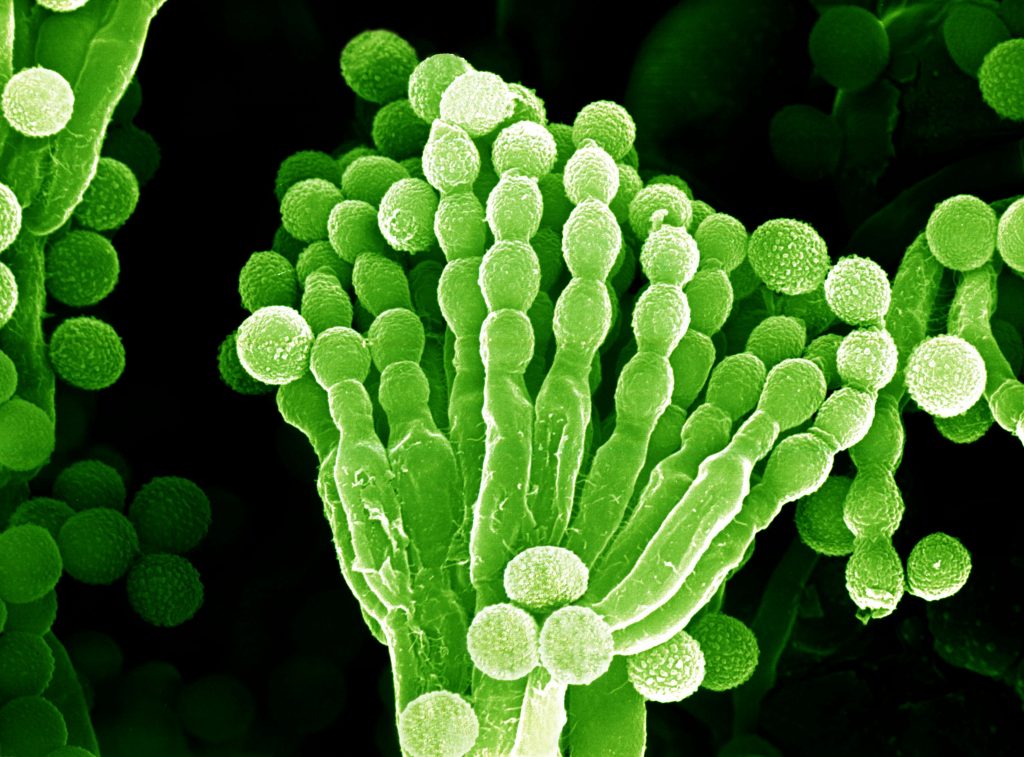New research presented at the 2019 Astrobiology Science Conference in Bellevue, Wa.
27 June 2019
Hyatt Regency Bellevue
900 Bellevue Way NE
Bellevue, Washington, 98004
24-28 June 2019
AGU press contact:
Liza Lester
+1 (202) 777-7494
[email protected]
Researcher contacts:
Marta Cortesão, German Aerospace Center (DLR) Cologne
[email protected]
BELLEVUE, WA—The International Space Station, like all human habitats in space, has a nagging mold problem. Astronauts on the ISS spend hours every week cleaning the inside of the station’s walls to prevent mold from becoming a health problem.
New research being presented here finds mold spores may also survive on the outside walls of spacecraft.
Spores of the two most common types of mold on the ISS, Aspergillus and Pennicillium, survive X-ray exposure at 200 times the dose that would kill a human, according to Marta Cortesão, a microbiologist at the German Aerospace Center (DLR) in Cologne, who will present the new research Friday at the 2019 Astrobiology Science Conference (AbSciCon 2019).

Mold grows on the International Space Station on a panel where exercise clothes were hung to dry.
Credit: NASA
Pennicillium and Aspergillus species are not usually harmful, but inhaling their spores in large amounts can sicken people with weakened immune systems. Mold spores can withstand extreme temperatures, ultraviolet light, chemicals and dry conditions. This resiliency makes them hard to kill.
“We now know that [fungal spores] resist radiation much more than we thought they would, to the point where we need to take them into consideration when we are cleaning spacecraft, inside and outside,” Cortesao said. “If we’re planning a long duration mission, we can plan on having these mold spores with us because probably they will survive the space travel.”
The new research also suggests planetary protection protocols designed to prevent visiting spacecraft from contaminating other planets and moons in our solar system with microorganisms from Earth may need to consider fungal spores a more serious threat.

Scanning electron micrograph of a Pennicillium mold producing chains of spores.
Credit: David Gregory & Debbie Marshall, CC BY
But fungi aren’t all bad. Cortesão investigates fungal species’ capacity to grow in the conditions of space with the aim of harnessing the microorganisms as biological factories for materials people might need on long space voyages. Fungi are genetically more closely related to humans than bacteria. Their cells have complex inner structures, like ours, with the cellular equipment needed to build polymers, food, vitamins and other useful molecules astronauts may need on extended trips beyond Earth.
“Mold can be used to produce important things, compounds like antibiotics and vitamins. It’s not only bad, a human pathogen and a food spoiler, it also can be used to produce antibiotics or other things needed on long missions,” Cortesão said.
Cortesão simulated space radiation in the laboratory, hitting fungal spores with ionizing radiation from X-rays, heavy ions and a type of high-frequency ultraviolet light that doesn’t reach Earth’s surface but is present in space. Ionizing radiation kills cells by damaging their DNA and other essential cellular infrastructure. Earth’s magnetic field protects spacecraft in low Earth orbit, like the ISS, from the heavy radiation out in interplanetary space. But spacecraft going to the Moon or Mars would be exposed.
The spores survived exposure to X-rays up to 1000 gray, exposure to heavy ions at 500 gray and exposure to ultraviolet light up to 3000 joules per meter squared. Gray is a measure of absorbed dose of ionizing radiation, or joules of radiation energy per kilogram of tissue. Five gray is enough to kill a person. Half a gray is the threshold for radiation sickness.
A 180-day voyage to Mars is expected to expose spacecraft and their passengers to a cumulative dose of about 0.7 gray. Aspergillus spores would be expected to easily survive this bombardment. The new research did not address their ability to withstand the combination of radiation, vacuum, cold, and low gravity in space. Experiments designed to test fungal growth in microgravity are set to launch in late 2019.
###
AGU and NASA will host the 2019 Astrobiology Science Conference (AbSciCon) in Bellevue, Washington, June 24-28, 2019, exploring the theme “Understanding and Enabling the Search for Life on Worlds Near and Far.” Among other topics, the conference will address planetary system interactions and habitability; alternative and agnostic biosignatures; understanding the environments of early Earth; evidence for early life on Earth; energy sources in the environment and metabolic pathways that use that energy; and ocean worlds near and far. #AbSciCon19
*****
Notes for Journalists:
Lead author Marta Cortesão will deliver an oral presentation about this research on Friday, 28 June 2019 from 11:15–11:30 a.m. PDT at the Hyatt Regency Bellevue, Cedar Ballroom.
Presentation Title:
502-5 “Fungal spore resistance to space radiation”
Session:
502 – Microbial response to space radiation I
Authors:
Marta Cortesão, and Ralf Moeller, Radiation Biology Department, Institute of Aerospace Medicine, German Aerospace Center DLR Cologne, Cologne, Germany
Tabea Schuetze and Vera Meyer, Department of Applied and Molecular Microbiology, Institute of Biotechnology, Technische Universität Berlin, Berlin, Germany
Akira Fujimori, National Institutes for Quantum and Radiological Science and Technology (NIRS/QST), Department of Basic Medical Sciences for Radiation Damages, Chiba, Japan
Potentially newsworthy presentations:
Media tip sheets organized by scientific topic and by date highlight additional, potentially newsworthy presentations selected by AGU’s public information office.
The full scientific program for AbSciCon 2019, including abstracts for more than 800 oral and poster presentations, is available online.